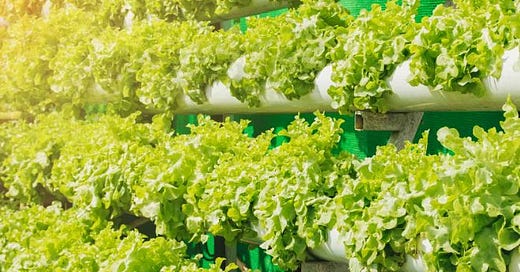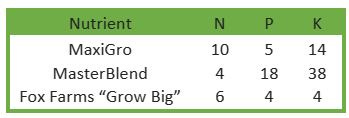Hydroponics 101
Hydroponic gardening isn’t exactly new or revolutionary. The approach to cultivating plants without soil has been around thousands of years. Historians make the case that the earliest example may be the Hanging Gardens of Babylon. If real, the gardens were relying exclusively on the Euphrates River as the source of irrigation where fertile soil was at a premium in the arid desert.
It is theorized that water was moved from the river using a bucket system or Archimedes screw to pull water up to the top terrace where it then made its way down the canals. Perhaps the truest historic representation of hydroponics, or at least aquaponics would come from the Aztecs who were reportedly using floating islands made of reed mats and river mud called Chinampas to grow food.
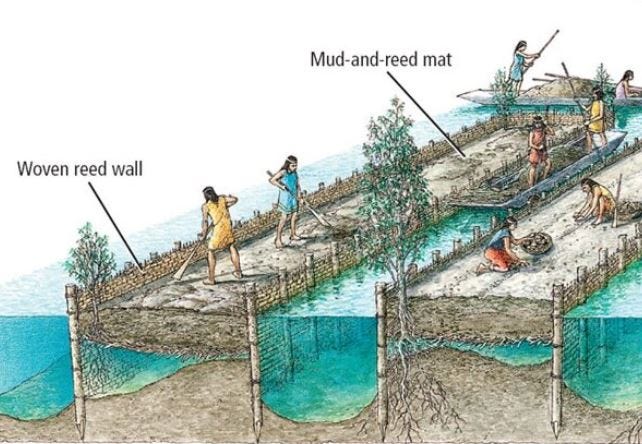

While the concepts employed by King Nebuchadnezzar II and the Aztecs at their core remain foundational to soilless cultivation, advances in hydroponics have grown tremendously in the last century thanks to a reintroduction in the 1920’s. Through years of study, we now fully understand that healthy plants require water, sunlight, carbon dioxide, and nutrients to thrive and we don’t necessary need dirt.
Hydroponic systems come in various forms, with some of the most common being nutrient film technique (NFT), deep water culture (DWC), and aeroponics. Each system has its unique way of delivering nutrients and oxygen to the plant roots while maintaining proper pH levels. All of these aforementioned systems rely on mechanical methods of circulating water across the plant roots or aeration systems.
In hydro systems, the plants are grown in a nutrient solution that contains all the necessary nutrients that the plant would normally get from the soil. Because of this, there is a huge debate on if hydroponically grown produce could be labeled as organic. That argument was put to rest in 2017. The National Organic Standards Board ruled to allow hydroponically grown produce as organic as long as growers use organic pesticides. They rationalized the growers are using the same base nutrients the plant would encounter in the soil.
Doesn’t that use a lot of water?
Even though the plants are grown in a water solution, it is estimated that hydroponic gardening utilizes up to 90% less water than ‘In Ground’ planting because you are reclaiming the water. Ground soil will eventually reach a saturation point in which the soil cannot hold any more liquid. When this occurs, you get a watershed or run off and that liquid is then lost to you. Worse yet that run off is pushing any chemical pesticides or fertilizers away from your plants where it is needed and into the local water table.
With hydroponics the water is consistently available to the plant as it is recycled through the system. For places with water restrictions hydroponics is very attractive. Companies like Driscol, the California strawberry producers, have huge greenhouses full of hydroponically growing strawberries.
Let’s talk tomatoes. Tomatoes can be grown hydroponically in five gallons of water. I grow six tomato plants a season, so that’s 30 gallons of water for a season, whereas growing them in soil can take more than 30 gallons of water per plant for the same yield. If you are interested in water conservation or live in an area where water may be scarce, Hydroponics maybe something for you to look at.
Does it take up a lot of space?
Growing plants hydroponically – depending on what you are growing – can produce more food per square foot than traditional soil.
I have a hydroponic system that I grow basil in, it occupies 3 feet of space in my greenhouse but supports 36 individual plants. Since basil typically needs to be thinned to 8 inches apart in the soil, I would only be able to grow half the basil if I didn’t grow it hydroponically.
Yields are also reported to be 35% higher with hydroponically grown veg because they are not in competition with nutrient leaching weeds, bad weather, bad soil, or wildlife. With hydroponics there are no crop-dusted pesticides, no vine boring beetles or slugs. I did have an issue with lettuce gnats, but I dusted my plants with food grade DE and the problem was solved overnight.
Growing hydroponically is not nearly as labor intensive as having to turn a garden and maintain it. it was no joke when God cursed Adam, Genesis 3 - Cursed is the ground for your sake; In toil you shall eat of it All the days of your life.” Noah’s parents reminded us again of this fact in chapter 5 “may this one comfort us in the labor and toil of our hands caused by the ground that the LORD has cursed." Farming is hard people! But it is also very rewarding.
It makes hydroponic seem almost like cheating and you can do it anywhere you have an outlet (or not if you’ve seen my article on Kratky growing: Growing Lettuce in a Sterilite Tote).
Too Good to be True.
The distinct disadvantage of hydroponic gardens – the high startup costs.
The Nutrient Film Technique (NFT) like what we do; runs the nutrient solution through a set of tubes over the root systems of the plants. The water is oxygenated as it passes through the system and the roots are always presented with fresh nutrient solution. This is honestly one of the more popular versions out there.
To do this you will need:
Some sort of piping to carry the water
A Reservoir to hold the nutrient rich water
A pump to circulate the water from your reservoir to your pipes
Net Pots, to hold the plants above or in the water (one guy uses pool noodles?)
Planting medium to help support the roots and plant as it grows – sponge, rockwool, hydro ton, perilite, whatever works best for your budget and setup I’ve seen pea-gravel in a rain gutter. In my experience if you are using rockwool use some sort of mechanical filter on the water before it goes back into the pump. Rockwool is made from natural rock that is melted down and spun into fiber. It is basically insulation. I used it once and will not use it again.
A filter to protect your pump from any organic material that gets washed down into your reservoir, maybe a good idea even if you are not using rockwool. You can get fancy with it taking a page from ‘Gold Rush’ have a settling reservoir that then feeds your pump pond that feeds into your wash plant LOL.
Possibly a grow light
Possibly a fan to mimic air circulation
Finally - nutrients
My initial hydro setup was just over $175.00 - that was the 36-hole rack, the pump, net pots, and sponges, and the nutrient. Monetarily, that’s a little more of an investment than just digging a hole and dropping some seeds.
What to grow?
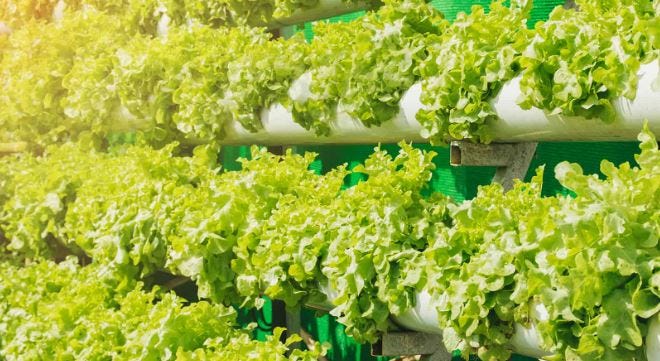
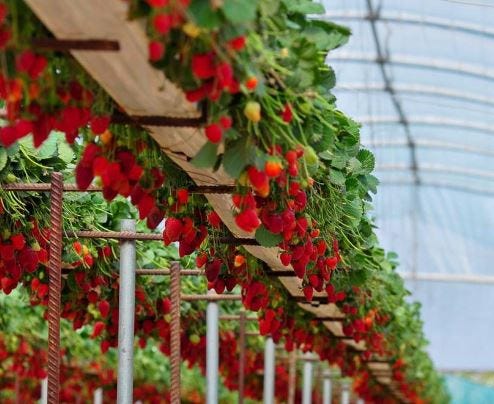
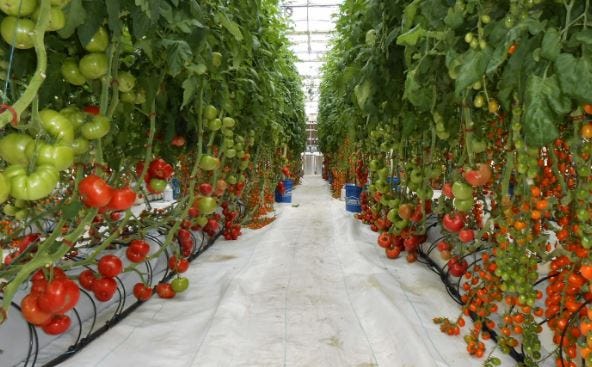
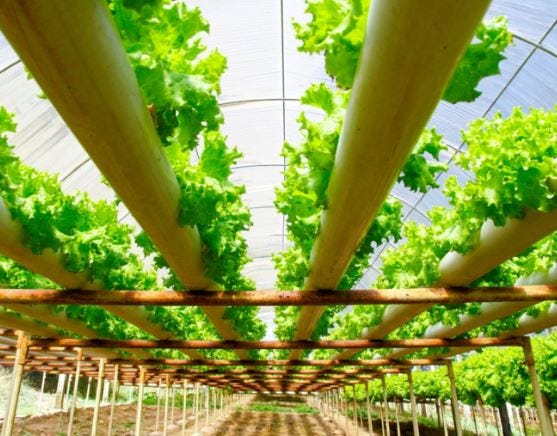
Hydroponics allows you to grow a wide variety of crops, but here's a short list of the top 10 plants that thrive in hydroponic systems:
Lettuce: Varieties like Romaine, Butterhead, and Leaf lettuce grow exceptionally well hydroponically and are popular choices due to their fast growth.
Spinach: Spinach is a nutrient-rich leafy green that does very well in hydroponic setups. It's a favorite for salads and cooking.
Basil: Herbs like basil flourish in hydroponics. They grow quickly and can be harvested continuously for a steady supply.
Tomatoes: Hydroponic tomato plants can yield high-quality, flavorful fruits with proper care and support.
Cucumbers: Compact cucumber varieties are well-suited for hydroponics. They benefit from trellising for support.
Bell Peppers: Both green and colored bell peppers can be grown hydroponically, and they tend to produce sweet and vibrant peppers.
Strawberries: Hydroponic strawberries are known for their sweet taste and can be grown vertically to save space.
Herbs (e.g., mint, cilantro, parsley): A variety of herbs can be cultivated hydroponically, providing fresh flavors for cooking.
Kale: This nutrient-dense green thrives in hydroponic systems and is a popular choice among health-conscious consumers.
Cherry or Grape Tomatoes: Smaller tomato varieties like cherry or grape tomatoes are well-suited for hydroponics, often producing prolific yields.
Success in hydroponics depends on maintaining the right nutrient balance, pH, and environmental conditions specific to each crop. Experimenting with different varieties and techniques can help you find the best fit for your hydroponic garden.
We eat a lot of Italian foods I make our own sauces; we have pesto about once week, so it was an easy decision to grow basil. Having an abundance of Basil on hand for us is not an issue and over the course of a couple years we will have made our money back. We never have to worry about it being out of pesto at the store again.
Nutrients
I did have a small scare about the nutrients because there was talk about runs on fertilizer at the beginning of the war in the Ukraine, but inflation has done more harm than a lack of product on the shelf. If you have a good compost plan, it is possible to run your system on compost tea – if you wanted to.
The chart below shows the top three ready to use nutrients on the market:
I use MaxiGro™ but any water-soluble nutrient would work, even regular blue miracle grow! You may need to supplement with other things like adding Epson salt for extra magnesium or spraying your leaves with chamomile to help with calcium, but your plants will let you know if something is off.
Your nutrient solution should be changed weekly for optimum growth. Follow the directions for whatever solution use chose. A general rule for established plants is to use 3 - 4 tsp per gallon (4 L) of water once per week during the vegetative cycle.
Not sold on NFT?
There are a couple of other methods, Kratky method, deep water culture (DWC), aquaponics with fish, or aeroponics which mist the plants. Basically, all plants need really is light, access to nutrients, and oxygen. In some combination. Your system doesn’t have to be complex. If you aren’t sure where to start, you can always start with a single mason jar, but I promise the Hydroponics bug will bite.
We have a few hydroponic projects on the horizon for our little suburban homestead. I hope you check back often to see our progress.
If you liked this article, check out our other content and don’t forget to subscribe for to keep up on new articles. You can also follow us on Rumble to see our progress at FatMommaFarms on Rumble. We want you to tell us about your garden journey below.

